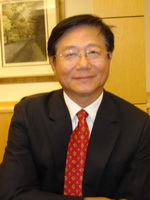Plenary Session
Carribean Ballroom, Wednesday, October 19, 2011
8:00 a.m. - 09:30 a.m.
Welcome
Ken-ya Hashimoto and Clemens Ruppel, General Co-Chairs
Technical Program
Yook-Kong Yong, Technical Program Chairs
Awards and Recognitions
- Achievement Award
- Distinguished Service Award
- Rayleigh Award
- Outstanding Paper Award
- Fellow Awards
- Distinguished Lecturer Award
Mike Garvey, UFFC-S President
Helmut Ermert, UFFC-S Awards Committee Chair
2011 UFFC-S Plenary Speaker
Bruce Chai: Single Crystals for Medical Applications
Single crystal is really not the desirable form of materials for any medical application unless there is really no other form of material that can offer the same or comparable performance at lower cost. The reason is simple. Crystals are expensive to make and it has limited physical dimensions. Still, single crystals are being used in both therapeutical and diagnostic applications.
The most common use of single crystals for therapeutical purpose is solid-state lasers. It is based on its unique property to deliver high peak power, short pulses under either Q-switched or mode-locked conditions. Single crystals used for this purpose include Nd-YAG, Er-YAG, CTH-YAG, Ruby, T-sapphire and Alexandrite. All these crystals are produced by CZ melt pulling technique under high temperatures near and over 2,000°C. The primary usage is for surgery, ophthalmology as well as for skin treatment. Even though the total number of laser systems is large, the total quantity (or net volume) of crystal materials used in these instruments is relatively small.
Single crystals used for diagnostic purpose are based either on its piezoelectric properties or scintillating properties. Ultra-sound scanner is one of the most common equipment in all hospitals PZT ceramics were the primary materials used as transducers in these scanners in the past. In recent years, it is gradually replaced by the lead-based single crystals such as PZN-PT and PMN-PT primarily for the high-end scanners. Both of these crystals were grown by vertical Bridgman techniques in sealed Pt-capsules. Again, the total number of ultrasonic scanners can be very large, but the amount (or net volume) of material used in each scanner is quite small.
The only medical application that uses fairly large quantity of single crystals is in medical imaging process based on the scintillating properties for gamma-ray radiation detection. X-ray has such a low energy ( < 100 KeV) so that thin film (sub-mm in thickness) of scintillating ceramics is more than enough to capture the radiation. Gamma-ray has much higher radiation energy ( > 500 KeV), it is necessary to use thick (cm in thickness) and high density materials in order to have sufficient stopping power. Moreover, once the gamma-ray is captured and scintillating emission is generated, it is needed to transmit the light to the photo-detectors. On cm scale in thickness, the best material to have the least scatter and highest transparency is single crystals. Today, SPECT uses large size (over 40 x 50 cm² in area) NaI(Tl) single crystal screen, while PET uses more than ten thousand cm long pixilated detectors to form a detector ring for each scanner. While BGO has been the crystal for PET scanners in the past, the new generation ToF scanners have all but replacing BGO detectors with LSO or LYSO detectors.
Single crystals will continue to be used in medical application but in constant threat to be replaced by other cheaper form materials. It is a very uncomfortable position to be in this business. For the specific examples mentioned here, it appears that they may stay in business for some time since there is really no known new materials on the horizon to replace them yet.
Biography of the Author Dr. Bruce Chai:

Dr. Bruce Chai is currently the President and CEO of Crystal Photonics. He is also the founder of the company.
Dr. Chai was born in 1947 in Shanghai and then moved to Taiwan with his parents. He got his B.S. degree in 1969 from National Taiwan University major in Geology. He then went to Yale University in 1970 for graduate studies and got his Ph.D. degree in 1975 major in Geology and Geophysics.
After a brief period as Post Doctor at Yale, he was recruited by Allied Chemical Corporation (now Honeywell Corporation) and joined the company in 1977. At the company, he is responsible for the research on single crystals for optics, acoustics and other applications. He was recruited again by CREOL (Center for Research in Electro-Optics and Lasers) of University of Central Florida (UCF) in 1988 and joined UCF as Professor of Physics, Electric Engineering and Mechanical Engineering in 1989.
In 1995, Professor Chai found Crystal Photonics, Inc. The Company is an OEM specialized in manufacture of optical single crystals for sensors, detectors, lasers and electro-optical applications. Currently, the company's primary product is the customized gamma-ray scintillating detector for high-end PET (Positron Emission Tomography) and PET/CT scanners. He also set up a plant in China for crystal fabrication and detector assembling.
Professor Chai is a Fellow of the Optical Society of America, a foreign member of the Russia Academy of Engineering and a honorary Professor of Shanghai Institute of Optics and Fine Mechanics, Chinese Academy of Sciences and also Fujian Institute of Structural Matters, Chinese Academy of Sciences. Over his career, Professor Chai has published more than 200 papers and has awarded over 35 U.S. patents.
|


